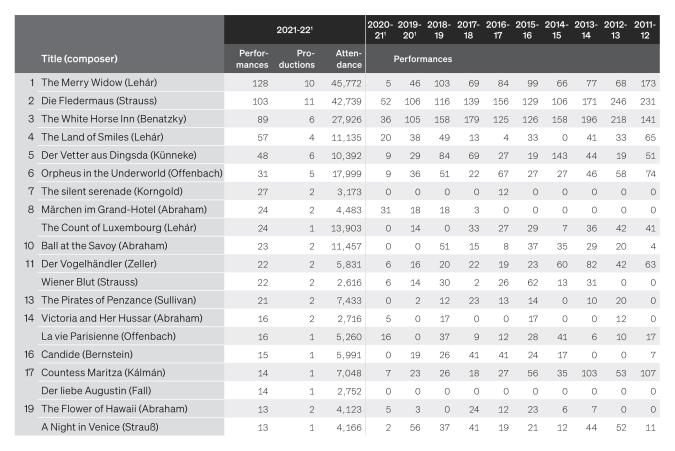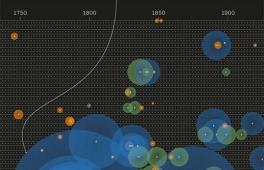The list of operettas with the highest number of performances documents which works are particularly established in the repertoires of theatres in Germany. Whereas the 2020-21 season analysis showed which works could have been performed at all for several times in front of an audience, conditions for the 2021-22 season were characterised by increasingly relaxed coronavirus protection measures. Audience numbers in 2021-22 remained below the pre-pandemic figures due to ongoing restrictions, but peformance figures stabilised.
In the 2021-22 season, the most frequently performed operettas in Germany were ‘The Merry Widow’ by Franz Lehár (128) and ‘Die Fledermaus’ by Johann Strauss (103). These works were the most attended ones. With ‘The Silent Serenade’ by Erich Wolfgang Korngold and ‘Der liebe Augustin’ by Leo Fall, works that had not been seen on German stages for many years were frequently performed again in the 2021-22 season.

Note
The work statistics are drawn from a complete survey based on online questionnaires (written questionnaires until 2013-14) submitted to all state, municipal and regional theatres and major private theatres in the German-speaking countries. Also included are festivals with theatre productions and training institutions where productions reach public performance under professional supervision. The figures cover the theatre’s entire repertoire (own and co-productions), including concert performance and guest appearances at other theatres, but with no claim to completeness; guest appearances by outside ensembles at the theatre’s own premises are excluded. As many theatres report number of productions but not attendance, gaps in the presentation may occur.
The 2014-15 statistics were accompanied by a revision of the classification system to take into account the diversity of work manifestations in different theatre formats. Since then, the decisive factor is no longer a predefined classification of a work into the three main categories of musical theatre (opera, operetta, musical), drama and ballet/dance, but the decision of the theatres as to how a production positions itself as a work. For this purpose, the classification system was expanded: since 2014-15, children‘s and adolescent‘s theatre, puppet theatre, revue/Liederabend and multi-genre projects/performances have been listed on an equal footing with the main categories. Operettas or operetta adaptations that are assigned to these categories are not included in these statistics. This also applies to productions that fall under the category Digital Theatre, which has been introduced in the 2019-20 season. Digital theatre includes both genuinely digital productions and stage productions, which are streamed live or posted online as recordings.
Footnotes
-
Due to the COVID-19 pandemic since March 2020, theatre operations were restricted. This is reflected in the season‘s statistics.
Source information
Compiled by the German Music Information Centre from the various issues of Wer spielte was? Werkstatistik, published annually by the German Theatre and Orchestra Association (Deutscher Bühnenverein).




